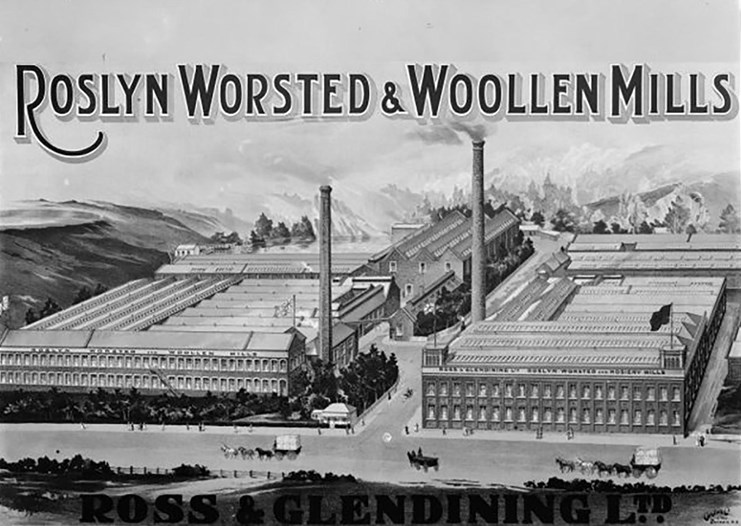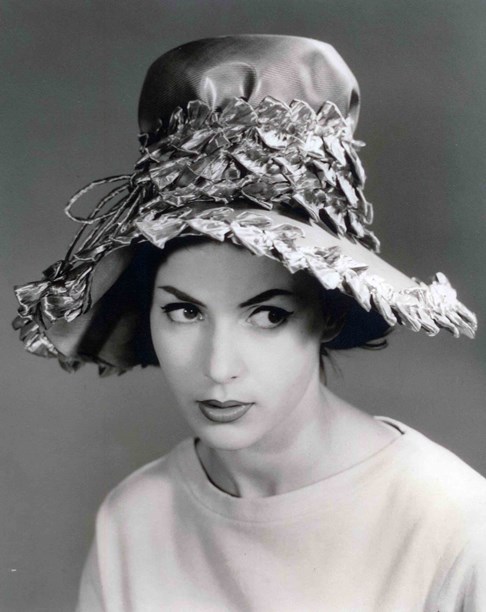Stories
Ross & Glendining
1862–1966

When Scottish immigrants John Ross and Robert Glendining took over a retail drapery business in Dunedin in August 1862, they began a partnership that led to one of the great manufacturing stories of the Otago region.
After three years, they turned their business, Ross & Glendining, into a wholesale operation. The move from being drapers and outfitters to importers and warehousemen began when they opened their new warehouse at 8 Stafford Street in Dunedin.
Ross & Glendining's first clothing factory was initially equipped with 21 new and second-hand sewing machines. Photo from 1902 courtesy of Hocken Collections, Dunedin, S09-529c.
Ross & Glendining imported a range of goods from Europe to supply the growing populations of Canterbury and Otago. The business grew to employ ‘travellers’ to sell to retailers all over New Zealand, including on the Otago goldfields. This included fashion items such as kid gloves and those made from silk and satin. But the most popular items purchased from Ross & Glendining at this time were blankets, hosiery, flannels and moleskin trousers (Doing Well and Doing Good by SRH Jones).
John Ross relocated to London in 1870 to run the firm’s London buying office, leaving Robert Glendining to run the day-to-day business in New Zealand. Over the next few decades the business expanded to include sheep farming, milling and manufacturing.
Up until the 1870s, the bulk of the clothing in New Zealand was either imported, made to measure by tailors and dressmakers, produced by large retailers or made at home. The introduction of the sewing machine made it possible to mass-produce clothing. One of the first to do so was Isaac Hallenstein & Co, also Dunedin-based. At this time, Ross & Glendining decided it made more sense for them to buy rather than manufacture.
To secure an alternative source of woollen cloth, Ross & Glendining built the Roslyn Woollen Mill in 1879. Located in the Kaikorai Valley in Dunedin, the mill was designed to produce a mixture of yarn, blankets, flannels and plaiding. Several years later, new knitting machines were installed to manufacture hosiery and knitwear. Roslyn Mill was also the first mill in the Southern hemisphere to produce worsted.

This lithograph, dated 1910, depicts the Roslyn Worsted and Woollen Mills in Dunedin. Image from Alexander Turnbull Library, Ref: 1/1-009178-G. Image © unknown.
In 1883 Ross & Glendining opened their own clothing factory opposite the Stafford St warehouse. They were facing falling sales of their imported goods (Doing Well and Doing Good). Most of the cloth came from the Roslyn Mill, while trimmings, buttons and thread were usually bought by John Ross in London. The factory made men’s and boys’ clothing, which was marketed under the Roslyn brand.

Ross & Glendining manufactured men's woollen swimwear under the Rosyln brand. Image courtesy of Museum of New Zealand Te Papa, GH017435. Image © CC BY-NC-ND 4.0.
Almost two decades later there were more than 500 people working at the Roslyn Mill. They used wool from the Ross & Glendining sheep farms to manufacture a range of woollen garments, including felt boots and shoes, hosiery, bathing suits, hats and coats. John Ross frequently returned to New Zealand but during one trip in 1899 he was "shocked by the intemperate habits of Glendining and his son" (Doing Well and Doing Good). He initiated the conversion of the partnership to a limited liability company, which meant that the business would continue in the case of the death of one or both of the partners. The majority of the shares were held by Robert and John, with the rest divided up between their families and senior managers in New Zealand and London.
By 1905 John Ross had returned to New Zealand permanently. He was closely involved in the company until the 1920s, when a new management team led by his son took over.

Advertising poster for Roslyn Overcoats, circa 1925. Artwork by David Payne. Image from Auckland Libraries Heritage Collections, 7-C1825.
The company continued to expand manufacturing during the first half of the 20th century. Factories in Dunedin, Invercargill, Christchurch, Te Awamutu, Auckland and Whangarei manufactured a wide range of clothing and shoes under a number of labels including Fleur Fashions, Argosy Suits, Plunket Flannel, Clifton Knitwear, Hi-Fi and Sportscraft. They also manufactured British and American labels under license, such as Anthony Squire Suits, Town Talk ties, Osti lingerie and Sacony Fashions.

Fleur Millinery was a subsidiary of manufacturer Ross and Glendining. Image © Ross & Glendining.
By the 1960s, however, share prices were falling. The board restructured the company and, in response to the growing Auckland market, they moved the Ross & Glendining head office to Auckland. The majority of the warehouses and a number of factories were closed. The sharemarket was "not impressed" by these activities (Doing Well and Doing Good, page 355). In 1966, Ross & Glendining was acquired by the United Empire Box group of companies. The century-old business was broken up and its assets were sold. Mosgiel Woollens Ltd bought the Roslyn Mill from UEB but the reprieve was only temporary. Roslyn closed in 1980 after Mosgiel went into receivership.
The names Ross and Glendining live on in two Dunedin streets - Ross Street and Glendining Ave and in the Ross Home for the elderly. The Stafford St factory has avoided demolition. It stands, empty and silent these days, still bearing the names of its founders.
Text by Kelly Dix. Banner image illustration by Heather Masters, courtesy of Museum of New Zealand Te Papa Tongarewa. Image © All rights reserved.
Last published February 2015.